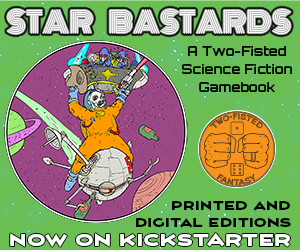Killshot
Killshot is a complete roleplaying game powered by the Optional System and published by Broken Ruler Games.
By The Warden
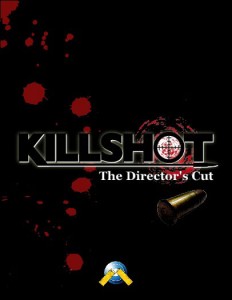
Welcome to the thirty-ninth Designer’s Diary, a regular column where designers are given the opportunity to take readers on an in-depth ride through the design and development process of their system, setting, or product. If you’d like to share your product in the Designer’s Diary column, send a message to aaron@roleplayerschronicle.com.
Learn more about Killshot here
Purchase Killshot: The Director’s Cut here
Designer’s Description
Killshot is an action/investigation RPG where the players take on the role of modern day professional assassins hired to kill marks. Each session involves the assassins taking out a mark and working as part of a Team to get the job done as efficiently and effectively as possible without attracting the attention of the police. Within each job is a list of objectives to complete; it’s not just about pulling the trigger. You have to find the mark, study their patterns, devise a plan, implement the plan, and get away scott free. How you get the job done is entirely up to your Team. How well you do depends on how the dice are rolled.
The game uses a new dice pool mechanic called the Optional System. Everyone involved in a scene are divided into Teams – including assassins – with a number of actions based on the number of characters per Team. Within an action, each individual has an option. If you roll dice for your option and succeed, you can roll again until you either fail a roll or use an automatic (non-dice) option. This is known as a bonus option.
There are two components to the game’s design and the first is investigative. Think of Killshot as a “reverse detective game” where instead of trying to figure out what happened after the fact, you’re trying to make it all happen. You have to think ahead and cover all the bases or else you’ll never have a chance to enjoy all that hard earned cash tucked inside that briefcase. If you simply walk right up to the mark and shoot him in the back of the head, you’ll be in jail by dawn. You have to learn as much information as you can about the mark and devise a strategy based on their habits, lifestyle, employment, and other factors. Plus you have to meet the qualifications set down by the client, so if they want someone’s death to look like a heart attack, you’ve got to make it look like a heart attack. All of this is done under the pressure of being caught, a matter handled by the Director by tracking the Evidence Points the assassins accumulate. The more Evidence Points you gain, the closer you’ll be to standing in front of a judge with handcuffs and an orange jumpsuit.
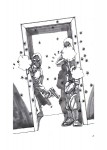 However, not everything goes according to plan and that’s where the second component comes into play: action. Killshot’s dice pool mechanic allows for an incredibly fast-paced and versatile combat sequence capable of playing out like the action scene of a big budget movie or your favorite novel. If you need to shoot your way out of a situation, this game can handle it in a big way. And when the job calls for a big, messy shootout, then get ready to let the bullets fly.
However, not everything goes according to plan and that’s where the second component comes into play: action. Killshot’s dice pool mechanic allows for an incredibly fast-paced and versatile combat sequence capable of playing out like the action scene of a big budget movie or your favorite novel. If you need to shoot your way out of a situation, this game can handle it in a big way. And when the job calls for a big, messy shootout, then get ready to let the bullets fly.
Purpose
I originally set out to conceive of a new dice mechanic almost two years ago; Killshot is the result of that work. There were two things about RPGs in general I found lacking: the ability to actively participate in your character’s defense and a lack of fluid, versatile, and realistic combat. When I talk about this last point, I’m talking about the turn sequence of practically every single RPG on the market – all the players go in a particular order and you can only do a couple of things before you have to hand your turn over to the next player. While this completely works within the confines of a tabletop game, I found it frustrating and restricting at times because it never lined up with what I imagined my character doing in my head. If you took your average RPG session and cut a fight sequence in a movie the same way, you’d have horrible pacing. I wanted to see if I could find a way to make a tabletop RPG play out exactly like every movie and novel we use as inspiration for our games.
To do this, there are three major adjustments to your typical game in Killshot: bonus options, opposed rolls, and the Edge. As mentioned before, a bonus option is whenever you make a successful dice roll, you get to go again and again until you fail or perform a non-dice option. This is what allows assassins to perform tasks like firing multiple shots at multiple targets or take on more than one opponent in a fistfight. With bonus options, you can now take a player’s turn and have it play out exactly as if it were cut from a popular TV series. The protagonist is approached by a hulking, bald-headed biker decked in black leather and grinning at the thought of beating this little man’s head in. As the brute swings and misses, the protagonist launches into his own attack with a series of punches to the gut, a kick to the knee dropping the biker down, and a roundhouse kick to the side of the face taking him out. The protagonist sighs in relief and runs towards his friend caught up in a situation of his own. That’s what a turn looks like in Killshot with dice rolled for every strike and block actually played out rather than become the final description from a single die roll.
Opposed rolls are what make it all happen. Equal emphasis is placed on active rolling to achieve something as well as preventing it from happening and the same traits and skills you use for your attacks can be applied to your defense. In Killshot, everything using dice requires an opposed roll, including things like jumping rooftops, climbing walls, spotting a clue, and more. The difficulty of a task is not based on a set difficulty number, but by a number of dice rolled by the Director, meaning a player never knows if their attempt will succeed or fail until they drop the dice. With each roll, your success is measured in hits to determine just how good it was (or how poor, should it come to that). By using opposed rolls, it’s possible for players to remain active within a scene even when it’s not their turn.
Finally, there’s the Edge. Think of it as the initiative marker in the game except that it’s never static. Whichever Team has the Edge can make active rolls; everyone else can only oppose. It moves between Teams and can be stolen from another. If you roll a critical defense (3 hits to a successful defense roll), you steal the Edge back for your Team. It’s a tactic you can use to your advantage to eliminate your opponents immediately, but if it doesn’t work, you’ve used up all your actions far too soon and they get to finish the round with a bit of pummeling.
The result is an incredibly effective mechanic accomplishing exactly what I set out to achieve and more. While I was originally designing a mechanic for action sequences, it is also impressively useful for investigation, social scenes, and more. It’s a universal mechanic capable of handling far more than I had originally intended and I couldn’t be happier with how it turned out.
Influences
One of my main goals was to avoid any major influences during the game’s design because I was looking to accomplish something I couldn’t find in other RPGs. That being said, one of the biggest influences for the opposed roll aspect was Iron Heroes from Malhavoc Press and being able to actively assist in your character’s defense rather than simply lock it down before heading out into danger.
More than anything, my biggest influence was my friend and fellow players and all those moments when game mechanics failed us. Those times when we didn’t have enough actions left to do what we needed to do or when we couldn’t do something to help because we made a lousy roll on our initiative half-an-hour ago. I could also look back on countless discussions I’ve had with one person in particular where we’d wonder why there were such limitations on how the game is played. If anything, I wrote the Optional System and Killshot with him in mind.
Research
Something I wanted to avoid was a game bogged down in reality. I think the best way to describe Killshot’s “reality” is that it works under Hollywood laws of physics. A car door can block bullets; you can grab a ledge while falling, run faster than an explosion, and all those other things Mythbusters has busted. If I tried to find the perfect balance of opposing dice to every conceivable situation, this game would never see the light of day and I’d have to continue my work in a padded cell.
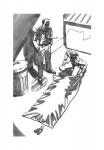 My wife and I are huge true crime buffs and our interest definitely played a part in Killshot, particularly when it came to Evidence Points. One of the essential goals of an assassin is to avoid getting caught, thereby forcing players to keep their work subtle and effective rather than loud and obnoxious. The trick to Evidence Points – as it is with most of the game – is that nothing’s written in stone. There are no rules for DNA, fingerprint evidence, blood splatter readings, and the like. It’s about attracting the attention to your work and giving the police cause to fire up a full investigation and pay attention to the tiniest clues. In the heart attack example above, an autopsy may be conducted to confirm cardiac arrest was the cause of death, but if there’s no reason to suspect foul play, the coroner won’t request a toxicology report eventually leading to the discovery of the poison used to induce the attack. True crime is not just about catching the guilty, it frequently involves seeing innocent people do time, so I studied the investigative styles of both types of cases to see what it was that made detectives look in the right direction and built that into the game.
My wife and I are huge true crime buffs and our interest definitely played a part in Killshot, particularly when it came to Evidence Points. One of the essential goals of an assassin is to avoid getting caught, thereby forcing players to keep their work subtle and effective rather than loud and obnoxious. The trick to Evidence Points – as it is with most of the game – is that nothing’s written in stone. There are no rules for DNA, fingerprint evidence, blood splatter readings, and the like. It’s about attracting the attention to your work and giving the police cause to fire up a full investigation and pay attention to the tiniest clues. In the heart attack example above, an autopsy may be conducted to confirm cardiac arrest was the cause of death, but if there’s no reason to suspect foul play, the coroner won’t request a toxicology report eventually leading to the discovery of the poison used to induce the attack. True crime is not just about catching the guilty, it frequently involves seeing innocent people do time, so I studied the investigative styles of both types of cases to see what it was that made detectives look in the right direction and built that into the game.
For the mechanics, I watched a variety of different action films and ended up building the Optional System with martial arts fight sequences in mind. If the game allowed these crazy bastards to kick three people with one sweep, simpler and realistic action should be a simple step backwards.
Art Direction
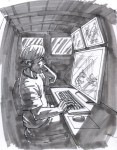 We all know a game’s art can explain the tone better than any words and that’s what makes finding the right artist(s) so important. I was lucky because the artist hired for Killshot, Kieron O’Gorman, was also one of the original playtesters and part of the Development Team helping to bring the mechanics to life. In fact, he was the very first person to play anything using the earliest version of the Optional System, so he’s seen this game progress from handwritten sheets of paper to the finished product. When the time came to actually hire him to draw, I didn’t have to explain what the pictures were supposed to explain or convey – he already knew. He just needed to know what everyone was doing physically. It was a major asset.
We all know a game’s art can explain the tone better than any words and that’s what makes finding the right artist(s) so important. I was lucky because the artist hired for Killshot, Kieron O’Gorman, was also one of the original playtesters and part of the Development Team helping to bring the mechanics to life. In fact, he was the very first person to play anything using the earliest version of the Optional System, so he’s seen this game progress from handwritten sheets of paper to the finished product. When the time came to actually hire him to draw, I didn’t have to explain what the pictures were supposed to explain or convey – he already knew. He just needed to know what everyone was doing physically. It was a major asset.
It’s also a well known fact art is the second most expensive endeavor in publishing a game (right after publication itself). In order to raise the money to have original artwork for Killshot, I used Kickstarter in an effort to raise just a few hundred and ended up with almost $1500. Without those backers, I’m not sure what Killshot would look like other than just some aspiring RPG with clip art and poor layout.
Gaming Experience
While I’d like to think Killshot is best suited for experienced players who prefer more independent games, playtesting has revealed everyone has a blast with it. It really depends on what you’re looking for and I think that’s one of the strengths of the game. Two of my wife’s cousins tried it out as their first RPG experience and they love the action, so I make a point of giving them an action-packed game whenever they play. For my Development Team, they thrive on the plotting and attention to detail with pulling off a job, so I aim to give them complex jobs with multiple objectives and difficult marks.
For the sake of this category, I’ll pin it down to something concrete. Killshot is a flexible game tailored to allow players to devise their own style and allow their dice pool to reflect personal choices related to their character’s abilities, environment, and decisions. The best tools representing this are stats and the attack roll. Every character has three stats: Body, Sense, and Mind. Each is assigned a number of d12s designating which is their strongest attribute. When you make an attack roll, the attacker chooses which stat they wish to apply, forcing the defender to apply the same stat to their roll. If you’re an intelligent combatant, your Mind is just as effective as your Body and you can outwit a strong opponent while a big brute can rely on speed and muscle to pound the crap out of a clever opponent just as easily. Only when you attempt to accomplish certain tasks – such as spotting a blood trail from the corner of your eye – are you forced to use a given stat (Sense, in this case).
At first glance, Killshot’s options appear to be a giant shopping list where you can only accomplish those options you’ve purchased with your training points, but this is only the surface. Every character has access to five base options capable of performing a wide variety of tasks but with little mechanical variety. For example, attack rolls are made with the Active base option where you and your opponent must apply the same stat to attack and defense rolls. But with trained options, you can force your opponent to use a different stat of your choice (Sense vs. Mind, for example) and apply a variety of additional effects and conditions without any effort or hits. This creates a game capable of great variety and possibility at first and encourages players to train themselves to become stronger, better characters capable of impressive feats without relying on levels.
Comparison
All of this establishes a game capable of subtle nuances and possibilities most RPGs can’t handle, particularly when it comes to initiative and the Edge. The term I like to use for the game is “organized chaos” because the Edge can pass back and forth between Teams and there’s no telling what the result will be because either side can make a horrible or awesome roll, yet with tools like the Tracker, you’ll never lose track of what’s going on in the scene.
If there’s anything I hope you walk away with from this Diary, it’s that anything is possible in Killshot. Picture your assassin pinned behind a kitchen counter, three thugs firing volleys of bullets with orders to kill. The assassin can hear the hiss of the propane stove from the bullet that tore through it and knows he has to make a hasty retreat from this enclosed area before the spark from a rogue bullet blows this place apart. Doing this requires the assassin to take out all three thugs before the end of his turn. In an ordinary game, this could be near impossible. In Killshot, anything is possible.
Development Process
The development of Killshot started with the development of the Optional System. In the beginning of 2011, I had a core version of the rules and adapted for a short D&D 4e campaign. This would give me an idea of how the game plays out in comparison to one of the most familiar brands on the market and help me distinguish some of the biggest differences, which could also become helpful in marketing down the road. My original intention was to work on a fantasy RPG with the Optional System.
It worked fine enough and there were plenty of tweaks from there. The problem with high fantasy RPGs is that there is a LOT of material to cover, particularly with spells. Without a proper base for a dice pool resolution mechanic tested beyond belief, fantasy games can become incredibly broken if the odds are too greatly stacked in the players’ or Director’s favor (meaning if casting spells were too damn hard, no one will want to use them). I realized I needed to start off “simple” with a base setting I could test the material’s foundation and start building from there in later games. Killshot was the result.
My personal design philosophy is to translate my imagination directly into game mechanics. In this case, I pictured a sequence in my head and tried to run it exactly as remembered through a trio of different RPGs, making notes on where it was troublesome or impossible. It was then a matter of deciphering possible solutions to allow those issues to be fixed so that the end result would be a series of actions and dice rolls at the table played out exactly as I had remembered it. Then new scenes had to be worked out. It was a backwards approach to system design, rather than devising the basic concept for turn sequences first.
At my heart, I’m a very visual person. Even with my Word file, I had the fonts selected and a very minor, simplified layout assigned into the first draft. My hope is that the end result is a RPG invoking strong visuals in the players’ minds.
It’s a wonderful release to negotiate the mechanics at their core and rebuild a car from scratch, as it were. As time went on and the pieces required to make Killshot work began falling into place, more revisions were made to allow these types of situations to manifest in the game as a play-by-play recollection of entertaining action sequences. If combat is the most complex function in a game, it should be built first so that the rest of the game can work from a combat-oriented frame. For example, there are no exceptional rules for combat over other actions in Killshot. The only mechanical difference between an attack roll and trailing a mark down a busy street is that an attack roll inflicts damage. In all other respects, they work exactly the same.
The Development Team was crucial to the rest of Killshot’s success and I was incredibly lucky to have a trio of players with experience and interest in many independent games and fellow contributors to the RPG industry in a wide age category. Fraser Ronald (from Sword’s Edge Publishing and the Accidental Survivors podcast), Kieron O’Gorman (also the interior artist), and Nick Dumais (movie aficionado, film student, and designated youth representative) tested out the game in many ways and were essential to identifying the bumps and how to smooth them over, particular when it came to best explaining the game to new players and Directors. In other words, we played.
Once we had a game where corrections were no longer noted, the next challenge was drafting into words and understandable sentences. My editor, Chris Groff (also from the Accidental Survivor podcast), worked his magic to ensure the rules, tone, and fun of the game came through in the text.
The final step was verifying the game could be adapted and expanded to create new and interesting extensions. I’ve never been fond of creating a single rulebook and maybe one adventure then moving on to the next project. For me, a game is not complete unless there are a dozen supplements to go with it (probably the result of being a TSR child). Aside from knowing I’ll be able to continue on Killshot’s possibilities and feel assured the game can easily be adapted at the table when needed.
 With the final result done and out in the world, the trick now is discovering if everything I think about the game comes through in the finished product and finding out if anyone has enjoyed reading it enough to try it at their table to experience the same thrill my players had when they rolled a kill shot. And if people paid for it too, that would be icing on the cake.
With the final result done and out in the world, the trick now is discovering if everything I think about the game comes through in the finished product and finding out if anyone has enjoyed reading it enough to try it at their table to experience the same thrill my players had when they rolled a kill shot. And if people paid for it too, that would be icing on the cake.

